The Modeling of Electromagnetic Behavior in the High-Frequency Range of Al2O3 and TiO2 Thermoplastic Composites in Support of Developing New Substrates for Flexible Electronics
Abstract
1. Introduction
2. Electromagnetic Simulation
3. Results and Discussion
4. Conclusions
Author Contributions
Funding
Data Availability Statement
Conflicts of Interest
References
- Wang, Y.; Wang, H.; Liu, F.; Wu, X.; Xu, J.; Cui, H.; Wu, Y.; Xue, R.; Tian, C.; Zheng, B.; et al. Flexible printed circuit board based on graphene/polyimide composites with excellent thermal conductivity and sandwich structure. Compos. Part A Appl. Sci. Manuf. 2020, 138, 106075. [Google Scholar] [CrossRef]
- Li, L.; Han, L.; Hu, H.; Zhang, R. A review on polymers and their composites for flexible electronics. Mater. Adv. 2022, 4, 726–746. [Google Scholar] [CrossRef]
- Kim, J.; Kim, B.-Y.; Park, S.D.; Seo, J.-H.; Lee, C.-J.; Yoo, M.J.; Kim, Y. Mechanical Durability of Flexible Printed Circuit Boards Containing Thin Coverlays Fabricated with Poly(Amide-Imide-Urethane)/Epoxy Interpenetrating Networks. Micromachines 2021, 12, 943. [Google Scholar] [CrossRef]
- Tong, C. Substrate and Encapsulation Materials for Printed Flexible Electronics. In Advanced Materials for Printed Flexible Electronics; Springer Series in Materials Science; Springer: Cham, Switzerland, 2022; Volume 317. [Google Scholar] [CrossRef]
- Dušek, K.; Koc, D.; Veselý, P.; Froš, D.; Géczy, A. Biodegradable Substrates for Rigid and Flexible Circuit Boards: A Review. Adv. Sustain. Syst. 2024, 9, 2400518. [Google Scholar] [CrossRef]
- Iftikhar, A.; Naseer, N.; Yildiz, S.K.; Gokcen, D.; Fida, A.; Shafique, M.F.; Saka, B. Silicon elastomer as flexible substrate: Dielectric characterization and applications for wearable antenna. Flex. Print. Electron. 2023, 8, 045001. [Google Scholar] [CrossRef]
- Zardetto, V.; Brown, T.M.; Reale, A.; Di Carlo, A. Substrates for flexible electronics: A practical investigation on the electrical, film flexibility, optical, temperature, and solvent resistance properties. J. Polym. Sci. Part B Polym. Phys. 2011, 49, 638–648. [Google Scholar] [CrossRef]
- Liang, C.; Yan, C.; Zhai, S.; Wang, Y.; Hu, A.; Wang, W.; Pan, Y. Recent Progress in Flexible Surface Acoustic Wave Sensing Technologies. Micromachines 2024, 15, 357. [Google Scholar] [CrossRef]
- McGibney, E.; Barton, J.; Floyd, L.; Barrett, J. The High Frequency Electrical Properties of Interconnects on a Flexible Polyimide Substrate Including the Effects of Humidity. IEEE Trans. Compon. Packag. Manuf. Technol. 2011, 1, 4–15. [Google Scholar] [CrossRef]
- Li, H.; Wei, P.; Wang, Y.; Zhu, Q.; Wang, X.; Gao, W.; Tao, L.; Ma, K.; Hu, Z.; Chen, W. High-frequency 5G substrate: Low dielectric biphenyl polyimide with low CTE and high thermal stability. Mater. Today Adv. 2024, 23, 100514. [Google Scholar] [CrossRef]
- Li, H.; Wang, X.; Wu, T.; Gong, Y.; Zhao, H.; Liu, Z.; Dastan, D.; Ma, K.; Hu, Z. Mechanical enhancement and dielectric properties of SiO2 contained polyimides under high frequency. J. Mater. Sci. Mater. Electron. 2023, 34, 1–10. [Google Scholar] [CrossRef]
- Gallah, H.; Mighri, F.; Ajji, A.; Bandyopadhyay, J.; Ben Ghorbel, N.A.; Castillo-Rodriguez, J. New Flexible Electrospun PET/TiO2 Composite Photoanode Layer for Dye-Sensitized Solar Cells, DSSCs, and Its Photovoltaic Performances. Mater. Sci. Appl. 2024, 15, 481–503. [Google Scholar] [CrossRef]
- Shin, C.-H.; Huseynova, G.; Kim, E.; Lee, J.; Yoo, S.; Choi, Y.; Lee, J.-H. Random Al2O3 nanoparticle-based polymer composite films as outcoupling layers for flexible organic light-emitting diodes. Opt. Express 2020, 28, 26170–26179. [Google Scholar] [CrossRef] [PubMed]
- Stroe, M.; Burlanescu, T.; Paraschiv, M.; Lőrinczi, A.; Matei, E.; Ciobanu, R.; Baibarac, M. Optical and Structural Properties of Composites Based on Poly(urethane) and TiO2 Nanowires. Materials 2023, 16, 1742. [Google Scholar] [CrossRef]
- Rehman, W.U.; Rasheed, T.; Naveed, A.; Ali, A. Thermoplastic polyurethane/rutile titanium dioxide composites tuned for hydrophobicity with effective reinforcement. J. Polym. Res. 2022, 29, 1–8. [Google Scholar] [CrossRef]
- Kolesnik, S.A.; Bulychev, N.A. Reinforcement of polymer composite materials by titanium dioxide nanoparticles synthesized in plasma discharge under ultrasonic cavitation. J. Phys. 2022, 2231, 012012. [Google Scholar] [CrossRef]
- Cazan, C.; Enesca, A.; Andronic, L. Synergic Effect of TiO2 Filler on the Mechanical Properties of Polymer Nanocomposites. Polymers 2021, 13, 2017. [Google Scholar] [CrossRef] [PubMed]
- Alheeti, O.A.R.; Fatalla, A.A. The characteristics tests of the PEKK-titanium oxide composite material. Int. J. Health Sci. 2022, 6, 1569–1576. [Google Scholar] [CrossRef]
- Al Zoubi, W.; Al-Hamdani, A.A.S.; Sunghun, B.; Ko, Y.G. A review on TiO2-based composites for superior photocatalytic activity. Rev. Inorg. Chem. 2021, 41, 213–222. [Google Scholar] [CrossRef]
- Ouyang, Y.; Bai, L.; Tian, H.; Li, X.; Yuan, F. Recent progress of thermal conductive ploymer composites: Al2O3 fillers, properties and applications. Compos. Part A Appl. Sci. Manuf. 2022, 152, 106685. [Google Scholar] [CrossRef]
- Meena, R.; Mali, H.S.; Meena, A.; Sharma, P.; Kumar, P.; Choudhary, K. Influence of alumina powder (Al2O3) on mechanical and tribological properties of injection molded polyoxymethylene composites. Mater. Today Proc. 2023. [Google Scholar] [CrossRef]
- Wondu, E.; Lule, Z.; Kim, J. Thermal Conductivity and Mechanical Properties of Thermoplastic Polyurethane-/Silane-Modified Al2O3 Composite Fabricated via Melt Compounding. Polymers 2019, 11, 1103. [Google Scholar] [CrossRef] [PubMed]
- Wei, T.; Wang, J.; Yu, X.; Wang, Y.; Wu, Q.; Chen, C. Mechanical and thermal properties and cytotoxicity of Al2O3 nano particle-reinforced poly(ether-ether-ketone) for bone implants. RSC Adv. 2019, 9, 34642–34651. [Google Scholar] [CrossRef] [PubMed]
- Nabhan, A.; Taha, M.; Ghazaly, N.M. Filler loading effect of Al2O3/TiO2 nanoparticles on physical and mechanical characteristics of dental base composite (PMMA). Polym. Test. 2022, 117, 107848. [Google Scholar] [CrossRef]
- Review of Fabrication of SAW Sensors on Flexible Substrates: Challenges and Future. Available online: https://eae.edu.eu/research_article/Review%20of%20fabrication%20of%20S.html (accessed on 28 October 2024).
- Wolf, H.; Gieser, H.; Maurer, L. Transmission lines on flexible substrates with minimized dispersion and losses. In Proceedings of the 2013 European Microwave Conference (EuMC), Nuremberg, Germany, 6–10 October 2013. [Google Scholar]
- Borchert, J.W.; Zschieschang, U.; Letzkus, F.; Giorgio, M.; Weitz, R.T.; Caironi, M.; Burghartz, J.N.; Ludwigs, S.; Klauk, H. Flexible low-voltage high-frequency organic thin-film transistors. Sci. Adv. 2020, 6, eaaz5156. [Google Scholar] [CrossRef]
- Brandon, E.; Wesseling, E.E.; Chang, V.; Kuhn, W.B. Printed Microinductors on Flexible Substrates for Power Applications. IEEE Trans. Compon. Packag. Technol. 2003, 26, 1521–3331. [Google Scholar]
- Ibrahim, G.H.; Zschieschang, U.; Klauk, H.; Reindl, L. High-Frequency Rectifiers Based on Organic Thin-Film Transistors on Flexible Substrates. IEEE Trans. Electron Devices 2020, 67, 2365–2371. [Google Scholar] [CrossRef]
- Njoku, C.C.; Whittow, W.G.; Vardaxoglou, Y.C. Study on the Variation in Dielectric Properties of Heterogeneous Substrates Composed of Nanomaterials. In Proceedings of the 5th European Conference on Antennas and Propagation, Rome, Italy, 11–15 April 2011; pp. 488–492. [Google Scholar]
- Zhang, D.; Han, C.; Zhang, H.; Zeng, B.; Zheng, Y.; Shen, J.; Wu, Q.; Zeng, G. The Simulation Design of Microwave Absorption Performance for the Multi-Layered Carbon-Based Nanocomposites Using Intelligent Optimization Algorithm. Nanomaterials 2021, 11, 1951. [Google Scholar] [CrossRef]
- Llave, Y.; Kambayashi, D.; Fukuoka, M.; Sakai, N. Power absorption analysis of two-component materials during microwave thawing and heating: Experimental and computer simulation. Innov. Food Sci. Emerg. Technol. 2020, 66, 102479. [Google Scholar] [CrossRef]
- Li, G.; Zhou, J. COMSOL-Based Simulation of Microwave Heating of Al2O3/SiC Composites with Parameter Variations. Symmetry 2024, 16, 1254. [Google Scholar] [CrossRef]
- Rothwell, E.J.; Frasch, J.L.; Ellison, S.M.; Chahal, P.; Ouedraogo, R.O. Analysis of the Nicolson-Ross-Weir method for characterizing the electromagnetic properties of engineered materials. Prog. Electromagn. Res. 2016, 157, 31–47. [Google Scholar] [CrossRef]
- Das, S. Matlab Code of Nicholson-Ross-Weir (NRW) Algorithm to Estimate the Permeability and Permittivity of EMI Shielding Materials. 2020. Available online: https://www.researchgate.net/publication/341275777_Matlab_code_of_Nicholson-Ross-Weir_NRW_Algorithm_to_estimate_the_permeability_and_permittivity_of_EMI_shielding_materials#fullTextFileContent (accessed on 28 October 2024).
- Sahin, S.; Nahar, N.K.; Sertel, K. A Simplified Nicolson–Ross–Weir Method for Material Characterization Using Single-Port Measurements. IEEE Trans. Terahertz Sci. Technol. 2020, 10, 404–410. [Google Scholar] [CrossRef]
- Dassault Systèmes, CST Studio Suite-Electromagnetic Field Simulation Software. Available online: https://www.3ds.com/products/simulia/cst-studio-suite (accessed on 28 October 2024).
- Aradoaei, M.; Schreiner, O.; Alexa, I.; Olteanu, A.; Pintilei, M.A.; Ciobanu, R.C.; Aradoaei, S. Simulating the Interaction of Electromagnetic Radiation with Matter, Within Nano/Micro-Conductive Composite. In Proceedings of the 2023 International Conference on Electromechanical and Energy Systems (SIELMEN), Craiova, Romania, 11–13 October 2023; pp. 1–6. [Google Scholar]
- Ciobanu, R.C.; Damian, R.F.; Schreiner, C.M.; Aradoaei, M.; Sover, A.; Raichur, A.M. Simulation of Dielectric Properties of Nanocomposites with Non-Uniform Filler Distribution. Polymers 2023, 15, 1636. [Google Scholar] [CrossRef]
- Damian, R.F.; Ciobanu, R.C. Modeling Absorbed Energy in Microwave Range for Nanocomposite Hot Melts Containing Metallic Additives. Appl. Sci. 2025, 15, 541. [Google Scholar] [CrossRef]
- Wypych, A.; Bobowska, I.; Tracz, M.; Opasińska, A.; Kadlubowski, S.; Krzywania-Kaliszewska, A.; Grobelny, J.; Wojciechowski, P. Dielectric Properties and Characterisation of Titanium Dioxide Obtained by Different Chemistry Methods. J. Nanomater. 2014, 2014, 124814. [Google Scholar] [CrossRef]
- Zhang, X.; Qiao, J.; Wang, F.; Lv, L.; Xu, D.; Jiang, Y.; Cui, P.; Wang, Q.; Liu, W.; Liu, J. Tailoring electromagnetic absorption performances of TiO2/Co/carbon nanofibers through tuning graphitization degrees. Ceram. Int. 2020, 46, 4754–4761. [Google Scholar] [CrossRef]
- Dhanasekaran, A.; Malakar, A.; Lakshmanan, A.; Stranak, V.; Bose, S.; Dhanaraj, K.; Venugopal, V. Electromagnetic Interference Shielding Properties of Conductive Polyaniline/TiO2/MoS2 Hybrid Composites. ACS Omega 2025, 10, 28143–28152. [Google Scholar] [CrossRef]
- Su, Q.; Wang, H.; He, Y.; Liu, D.; Huang, X.; Zhong, B. Preparation of CIP@TiO2 composite with broadband electromagnetic wave absorption properties. Int. J. Miner. Met. Mater. 2024, 31, 197–205. [Google Scholar] [CrossRef]
- Prince, M.E.; Tamilarasi, K.; Thiagamani, S.M.K.; Hashem, M.; Fouad, H.; Ansari, A. Effects of TiO2 nanoparticles on the dielectric and electromagnetic shielding performance of PVA/POM hybrid nanocomposites. Polym. Technol. Mater. 2024, 63, 1874–1886. [Google Scholar] [CrossRef]
- Vakhitov, M.; Klygach, D.; Kudryavtsev, O.; Zhikharev, M.; Knyazev, N.; Malkin, A.; Trukhanov, A. Highly efficient functional composites based on Al2O3 for combined electromagnetic and mechanical protection. Ceram. Int. 2020, 46, 17584–17590. [Google Scholar] [CrossRef]
- Regis, V.; Šadl, M.; Brennecka, G.; Bradeško, A.; Tomc, U.; Uršič, H. Investigation of Structural and Electrical Properties of Al2O3/Al Composites Prepared by Aerosol Co-Deposition. Crystals 2023, 13, 850. [Google Scholar] [CrossRef]
- Chen, H.; Wang, Y.; Zhang, W.; Nan, Y.; Yue, X.; Zhang, Y.; Fan, H. Effect of Al2O3 and BN compounding on thermal and mechanical properties of PP composites. Mater. Today Commun. 2023, 37, 107300. [Google Scholar] [CrossRef]
- What Are S-parameters? Available online: https://www.ansys.com/simulation-topics/what-are-s-parameters (accessed on 28 October 2024).
- Vanskeviče, I.; Kinka, M.; Banys, J.; Macutkevič, J.; Schaefer, S.; Selskis, A.; Fierro, V.; Celzard, A. Dielectric and Ultrasonic Properties of PDMS/TiO2 Nanocomposites. Polymers 2024, 16, 603. [Google Scholar] [CrossRef] [PubMed]
- Liu, X.; Li, X.; Lei, X.; Zhang, D.; Liu, Z.; Long, X.; Gong, R. Research on dielectric and microwave absorbing properties of TiO2/TiB2/Thermoplastic polyurethanes (TPU) composite materials. J. Phys. Conf. Series 2022, 2248, 012012. [Google Scholar] [CrossRef]
- Veselý, P.; Froš, D.; Hudec, T.; Sedláček, J.; Ctibor, P.; Dušek, K. Dielectric spectroscopy of PETG/TiO 2 composite intended for 3D printing. Virtual Phys. Prototyp. 2023, 18, e2170253. [Google Scholar] [CrossRef]
- Das, S.K.; Bharatiya, D.; Minz, S.; Saraswat, R.; Swain, S.K. Effect of clay on dielectric behaviour of TiO2 embedded PVDF nanocomposite for charge storage applications. Mater. Sci. Semicond. Process. 2025, 192, 109480. [Google Scholar] [CrossRef]
- Gaabour, L.H. Effect of addition of TiO2 nanoparticles on structural and dielectric properties of polystyrene/polyvinyl chloride polymer blend. AIP Adv. 2021, 11, 105120. [Google Scholar] [CrossRef]

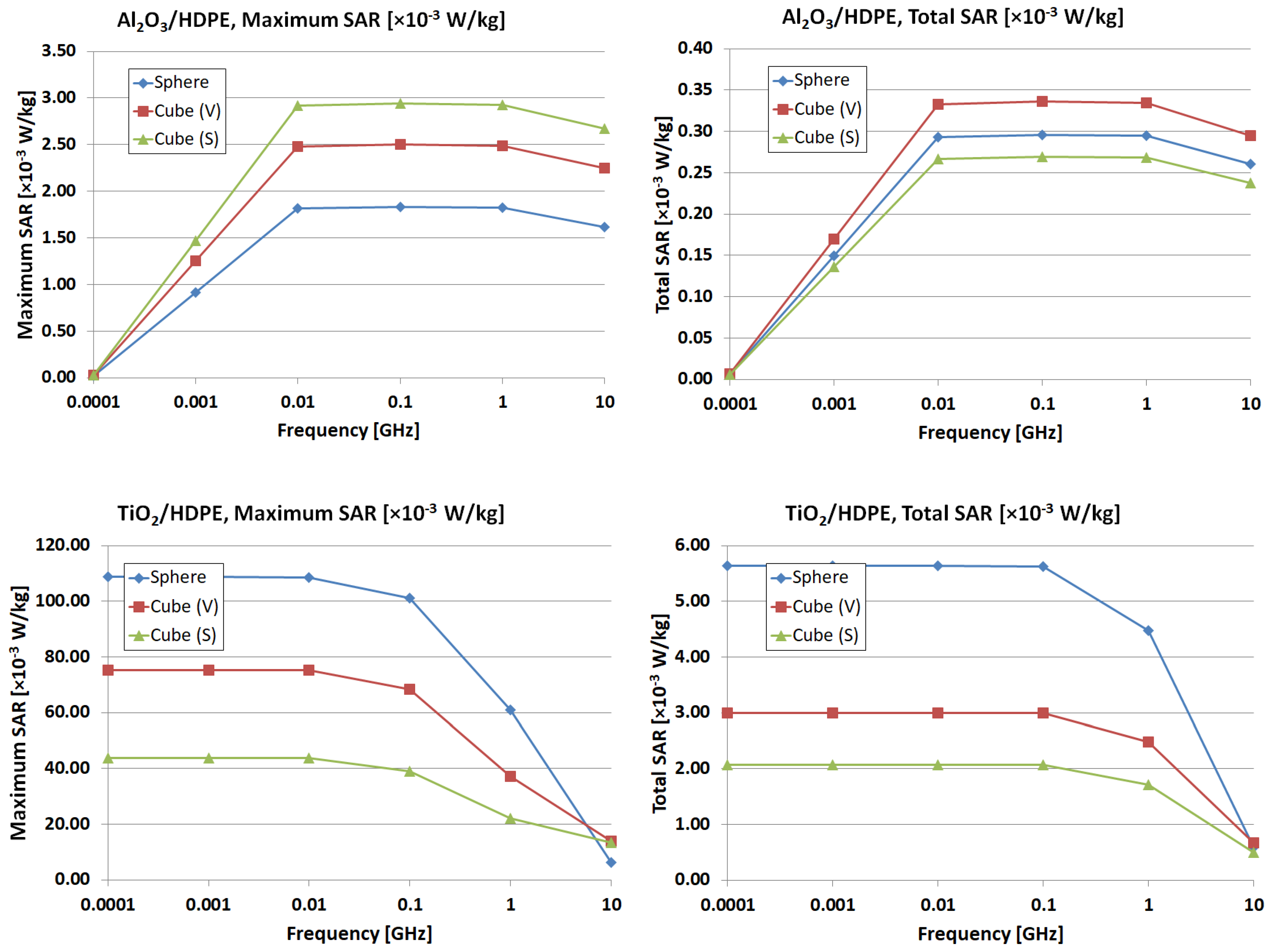
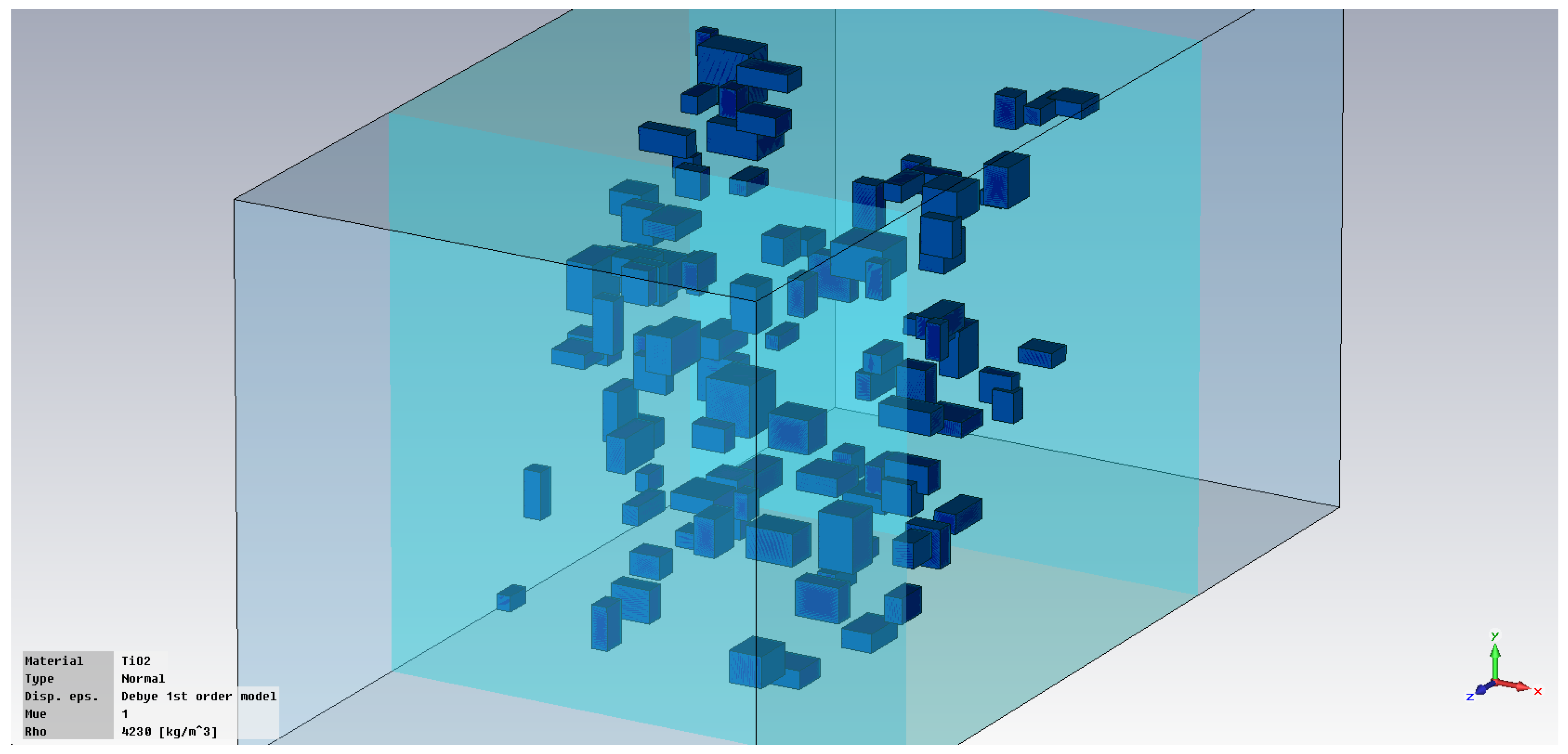
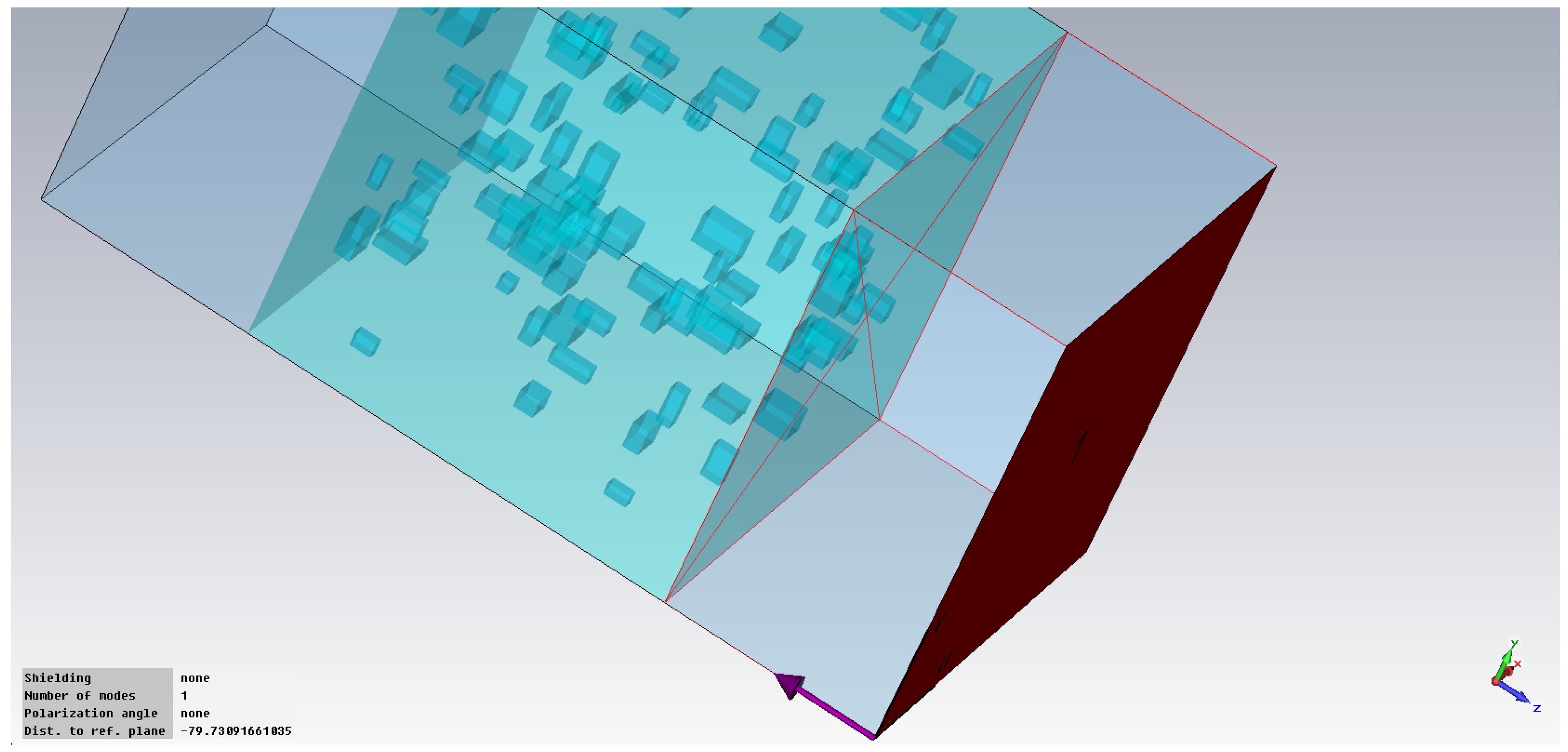
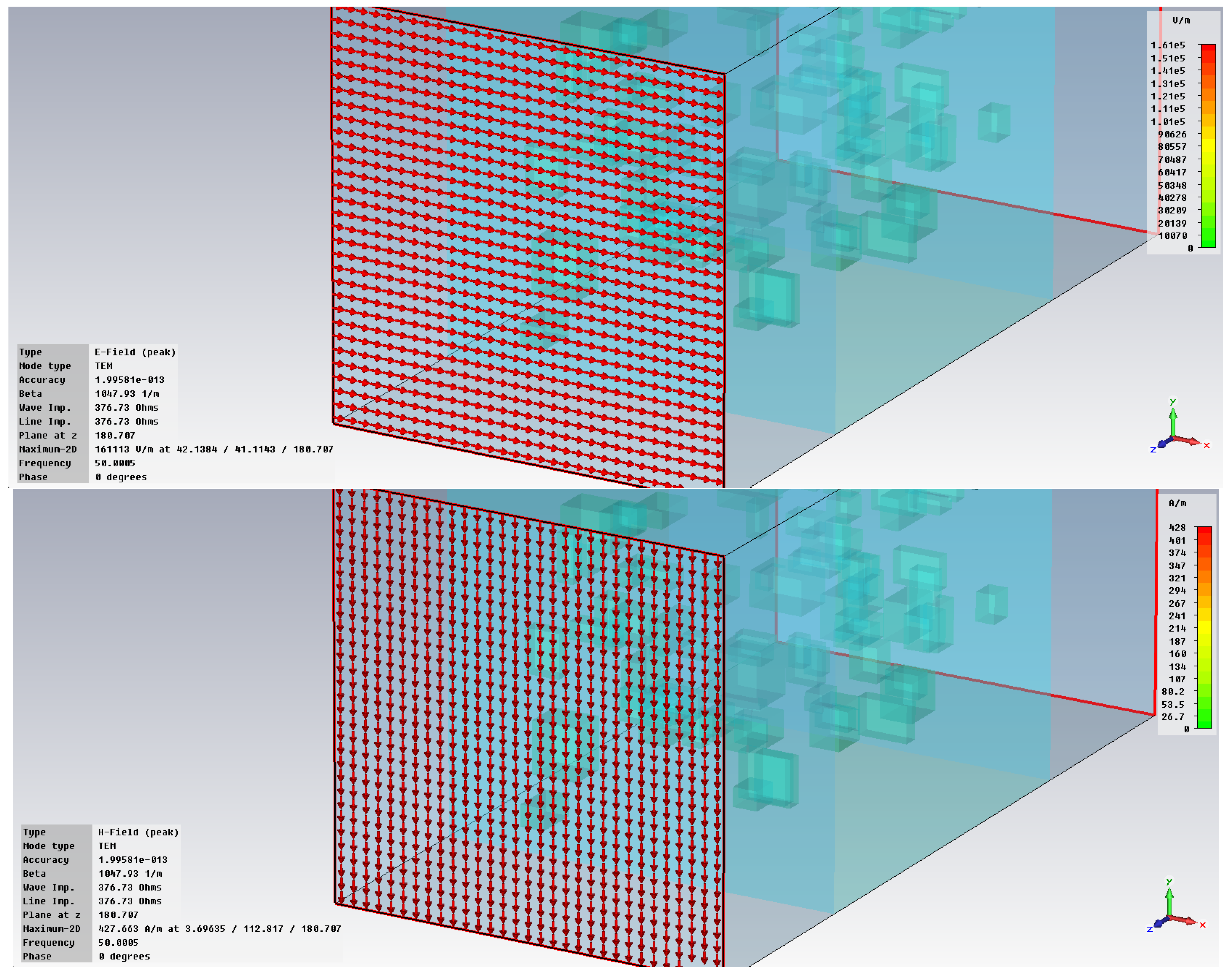

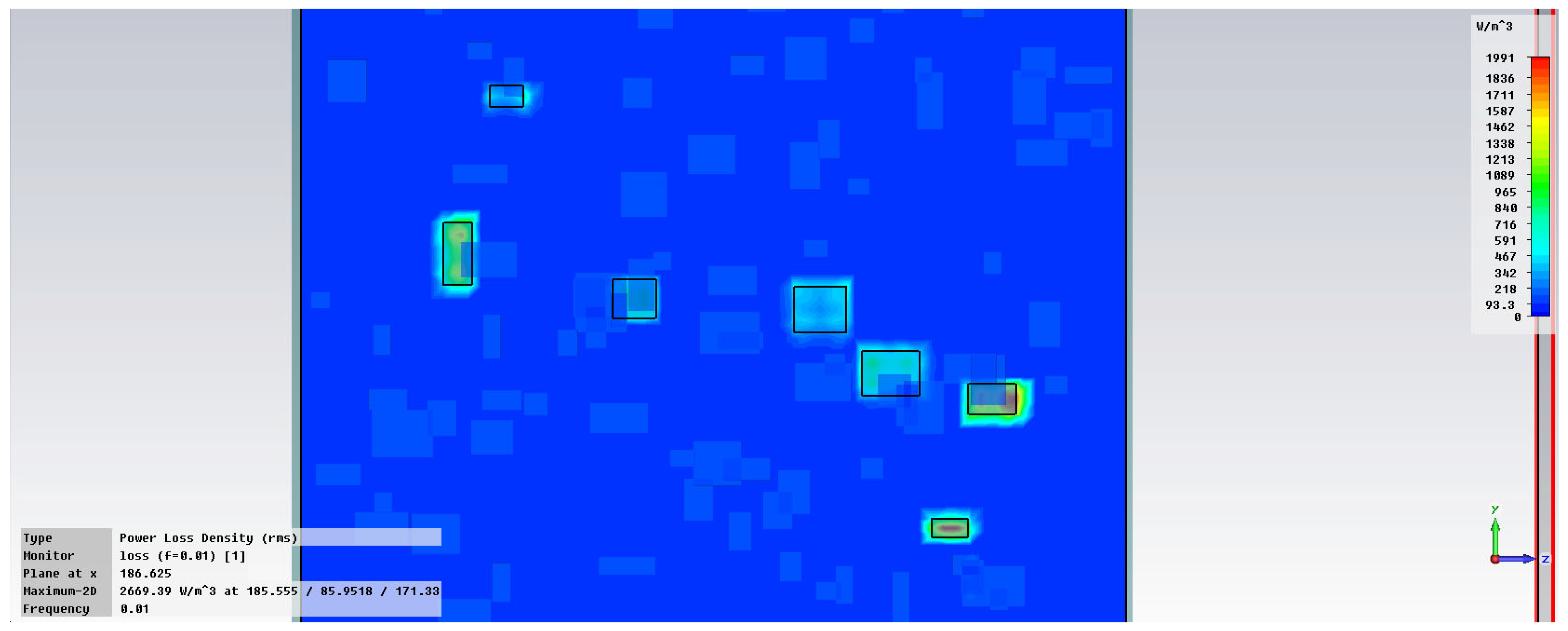
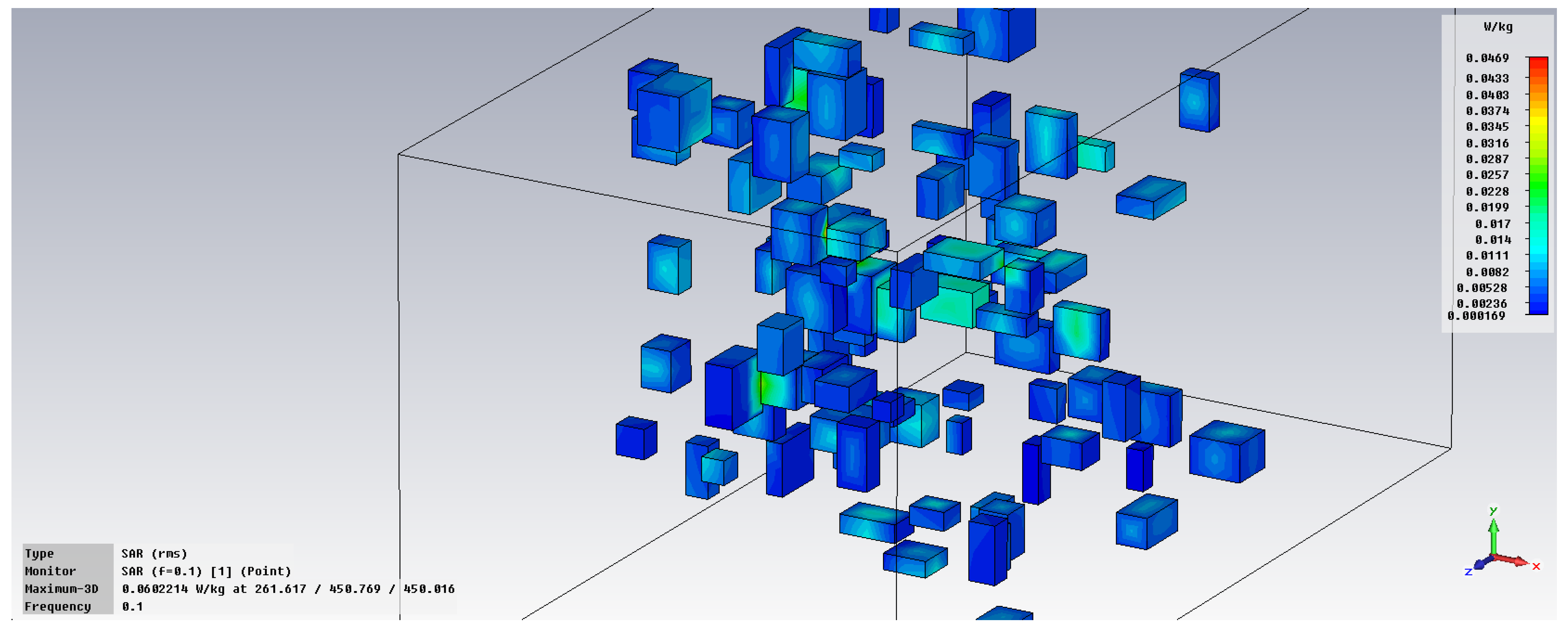
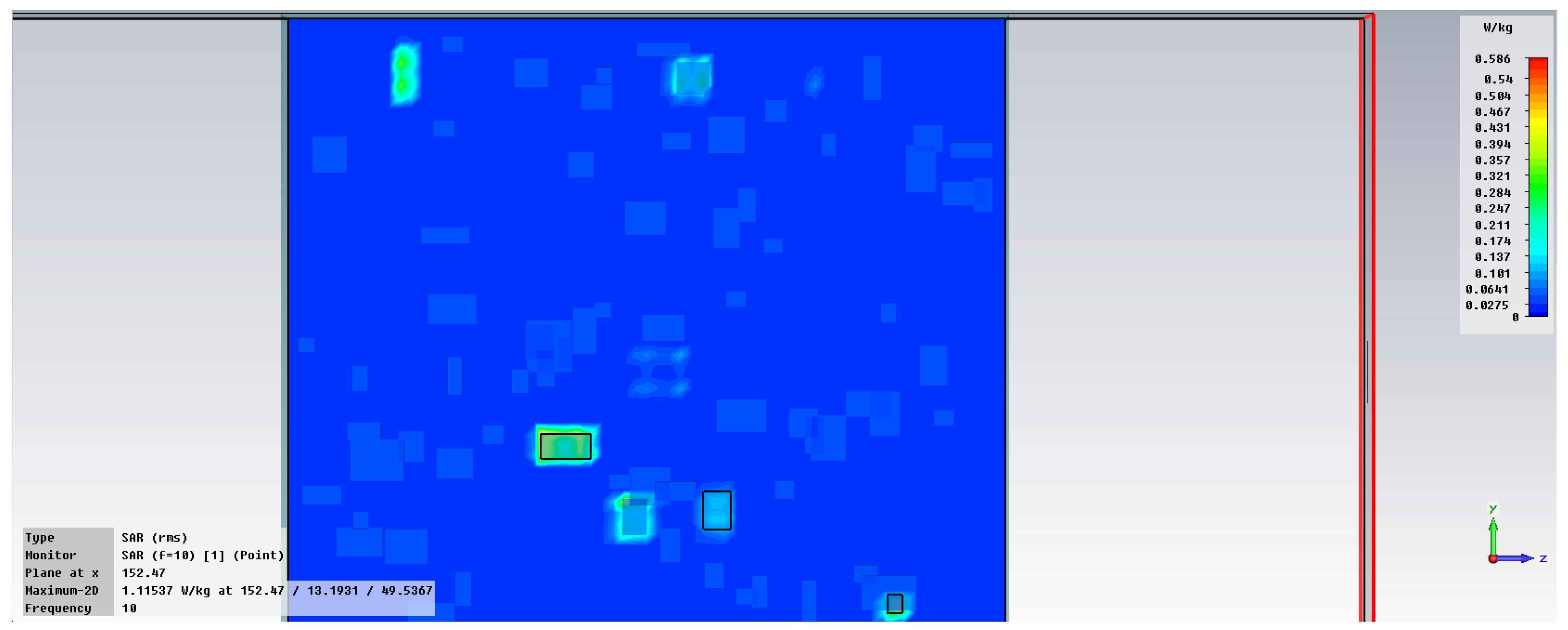
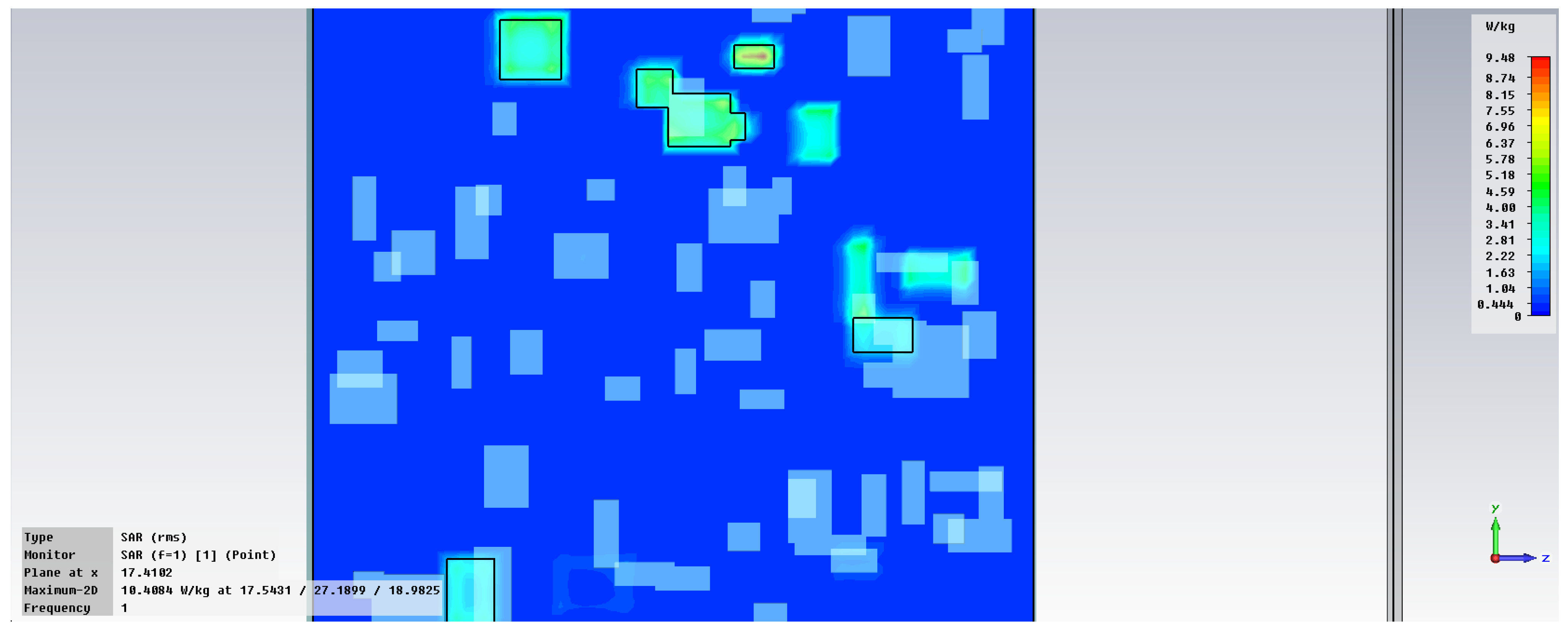
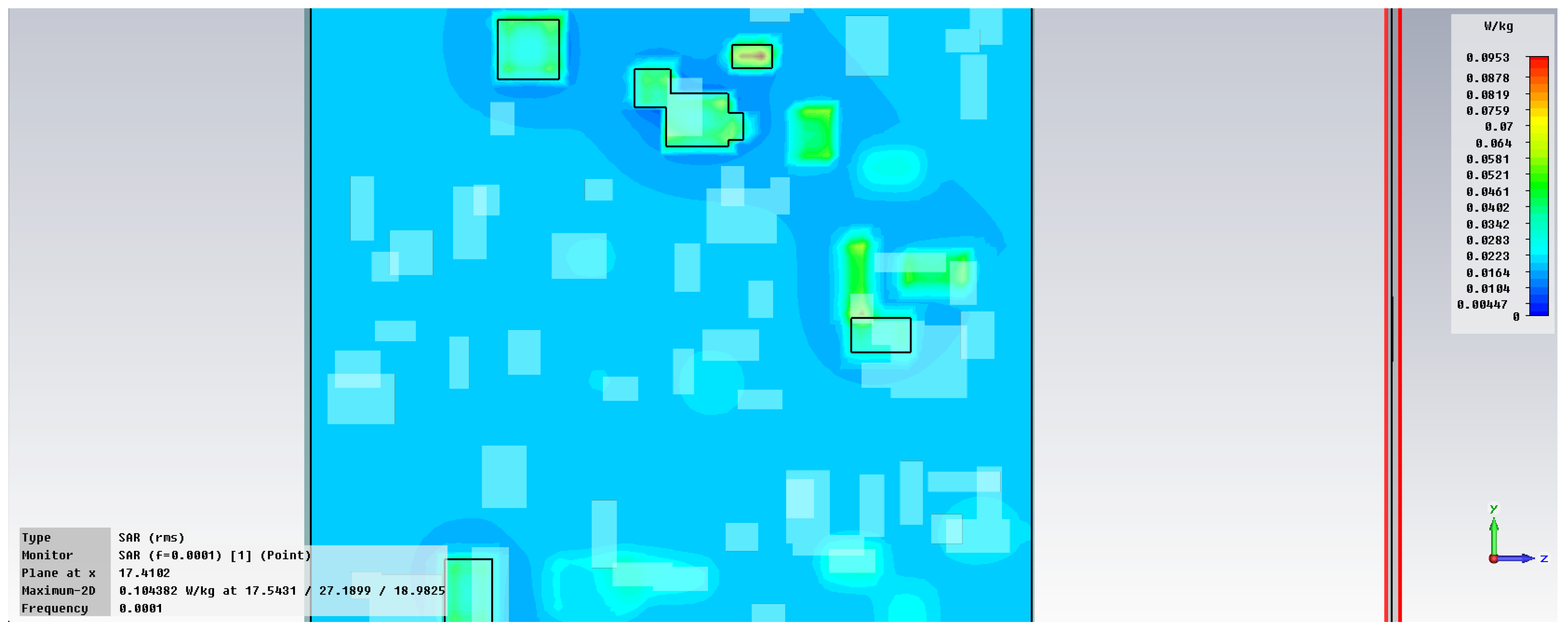
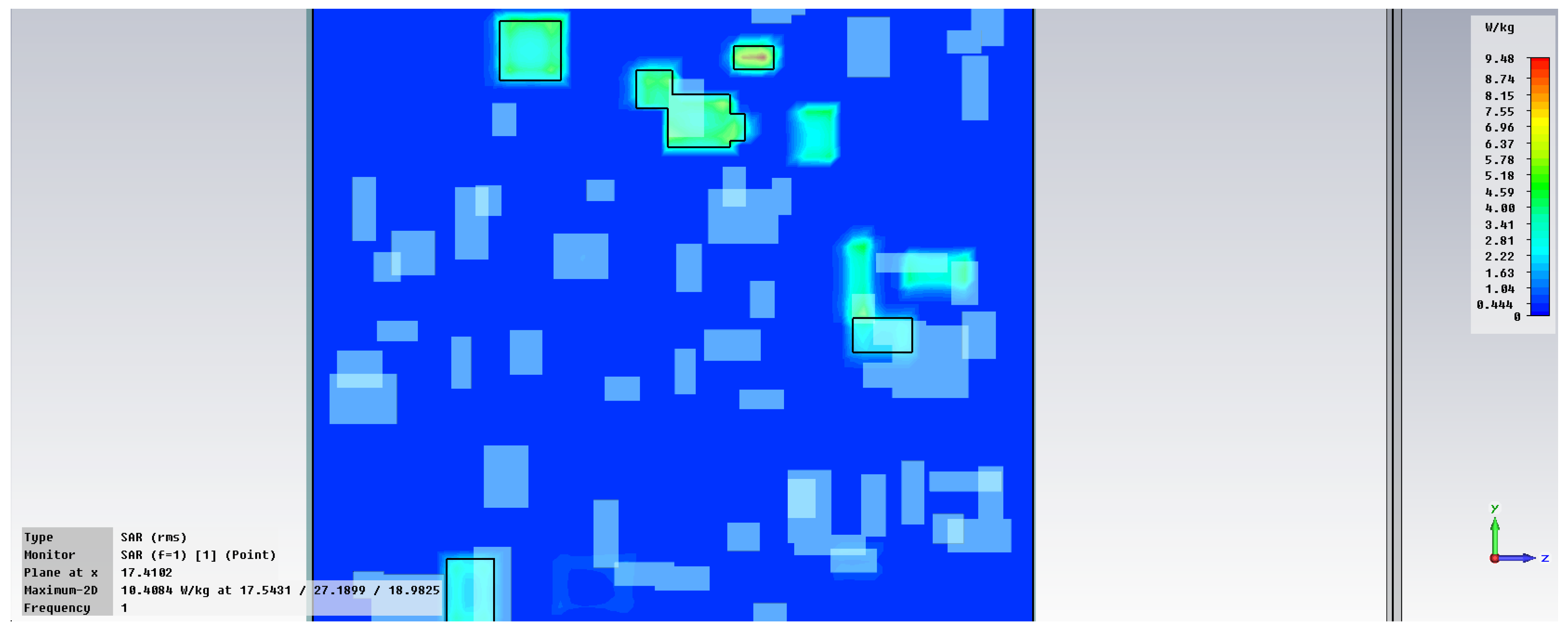


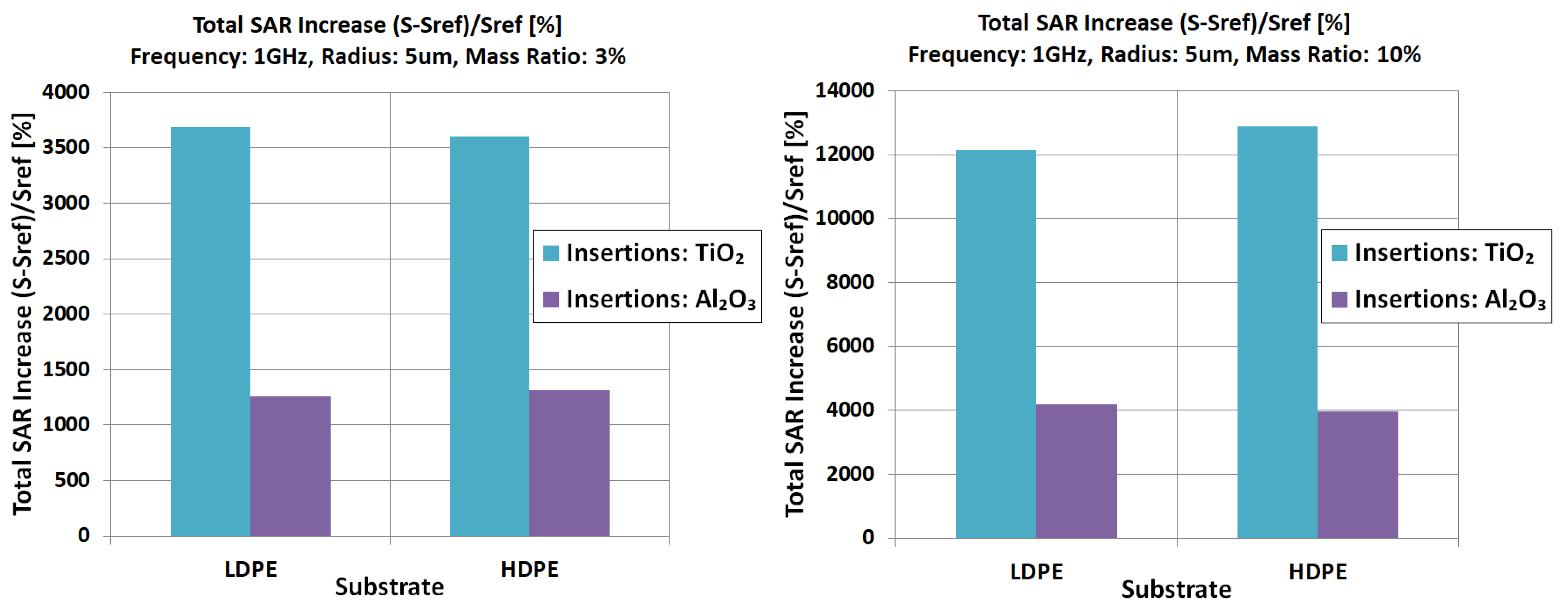

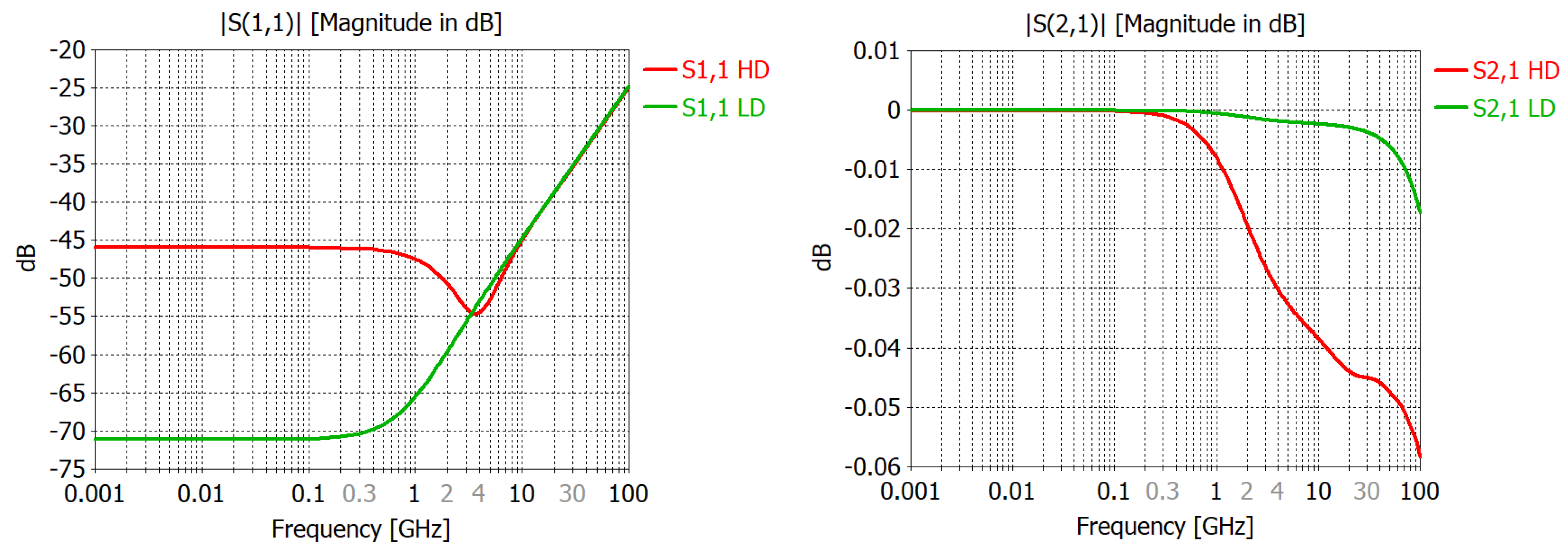
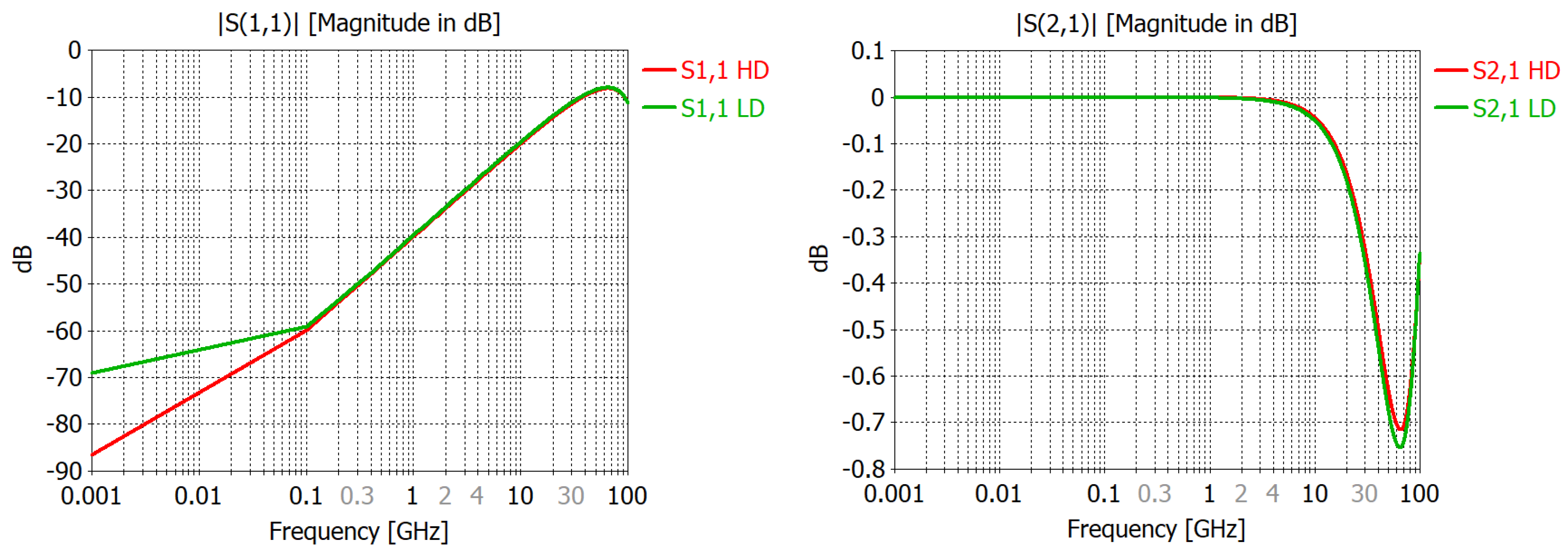

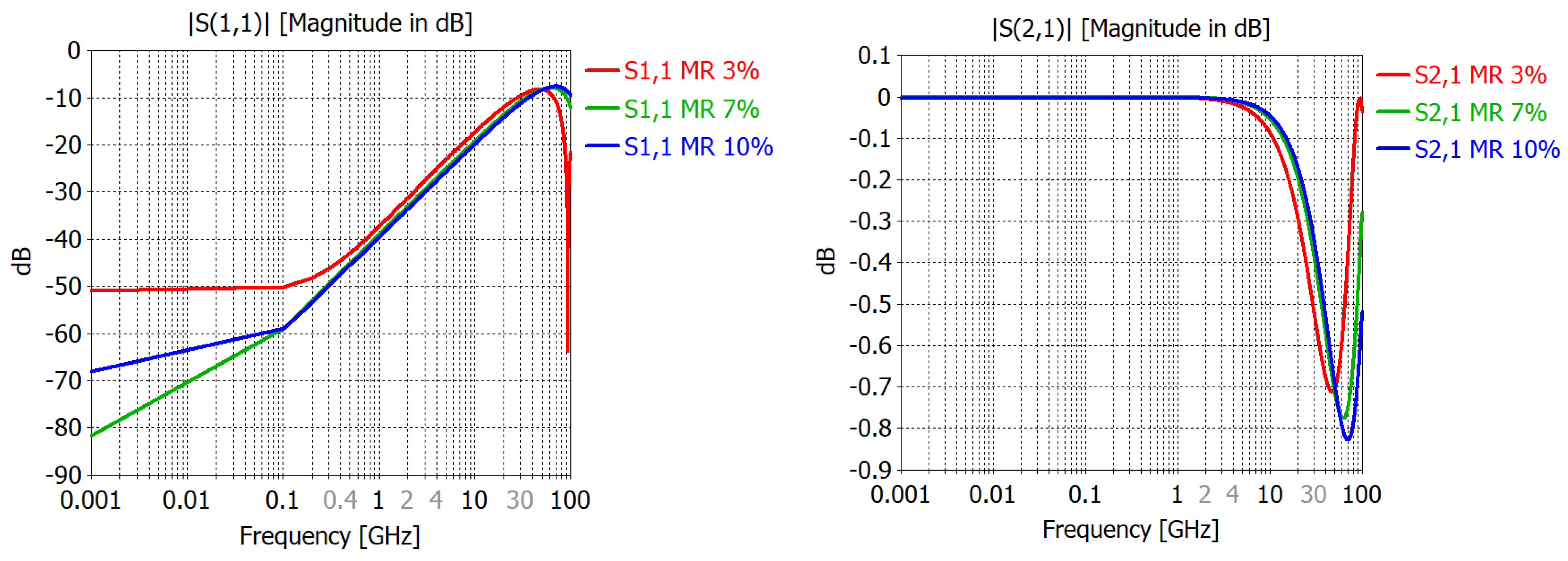
| RSph [μm] | 1 | 5 | 25 | |
| RCube [μm] | 1.612 | 8.06 | 40.3 | |
| Substrate | Insertion MR [%] | L = W = H [μm] | ||
| HDPE | 10% | 27.857 | 139.28 | 696.42 |
| 7% | 31.636 | 158.18 | 790.89 | |
| 3% | 42.415 | 212.07 | 1060.4 | |
| LDPE | 10% | 28.081 | 140.41 | 702.03 |
| 7% | 31.892 | 159.46 | 797.31 | |
| 3% | 42.762 | 213.81 | 1069.1 | |
| RSph [μm] | 1 | 5 | 25 | |
| RCube [μm] | 1.612 | 8.06 | 40.3 | |
| Substrate | Insertion MR [%] | L = W = H [μm] | ||
| HDPE | 10% | 26.904 | 134.52 | 672.59 |
| 7% | 30.544 | 152.72 | 763.61 | |
| 3% | 40.936 | 204.68 | 1023.4 | |
| LDPE | 10% | 27.12 | 135.6 | 677.99 |
| 7% | 30.792 | 153.96 | 769.79 | |
| 3% | 41.271 | 206.36 | 1031.8 | |
| Matrix | LDPE | HDPE |
|---|---|---|
| Model type | Normal | Normal |
| Thermal conductivity | 0.48 [W/K/m] | 0.51 [W/K/m] |
| Density | 945 kg/m3 | 964 kg/m3 |
| Dielectric permittivity | 2.2 | 2.4 |
| Magnetic permeability | 1 | 1 |
| Specific heat | 1.9 kJ/K/kg | 1.9 kJ/K/kg |
| Material | Al2O3 | TiO2 |
|---|---|---|
| Model | Normal | Normal |
| Dielectric permittivity | 9.4 | 63.7 |
| Magnetic permeability | 1 | 1 |
| Thermal conductivity | 0.88 kJ/K/kg | 0.69 kJ/K/kg |
| Density | 3800 kg/m3 | 4230 kg/m3 |
| Specific heat | 0.88 kJ/K/kg | 0.69 kJ/K/kg |
Disclaimer/Publisher’s Note: The statements, opinions and data contained in all publications are solely those of the individual author(s) and contributor(s) and not of MDPI and/or the editor(s). MDPI and/or the editor(s) disclaim responsibility for any injury to people or property resulting from any ideas, methods, instructions or products referred to in the content. |
© 2025 by the authors. Licensee MDPI, Basel, Switzerland. This article is an open access article distributed under the terms and conditions of the Creative Commons Attribution (CC BY) license (https://creativecommons.org/licenses/by/4.0/).
Share and Cite
Damian, R.F.; Pachiu, C.; Mocanu, A.; Trandabat, A.; Ciobanu, R.C. The Modeling of Electromagnetic Behavior in the High-Frequency Range of Al2O3 and TiO2 Thermoplastic Composites in Support of Developing New Substrates for Flexible Electronics. Crystals 2025, 15, 637. https://doi.org/10.3390/cryst15070637
Damian RF, Pachiu C, Mocanu A, Trandabat A, Ciobanu RC. The Modeling of Electromagnetic Behavior in the High-Frequency Range of Al2O3 and TiO2 Thermoplastic Composites in Support of Developing New Substrates for Flexible Electronics. Crystals. 2025; 15(7):637. https://doi.org/10.3390/cryst15070637
Chicago/Turabian StyleDamian, Radu F., Cristina Pachiu, Alexandra Mocanu, Alexandru Trandabat, and Romeo Cristian Ciobanu. 2025. "The Modeling of Electromagnetic Behavior in the High-Frequency Range of Al2O3 and TiO2 Thermoplastic Composites in Support of Developing New Substrates for Flexible Electronics" Crystals 15, no. 7: 637. https://doi.org/10.3390/cryst15070637
APA StyleDamian, R. F., Pachiu, C., Mocanu, A., Trandabat, A., & Ciobanu, R. C. (2025). The Modeling of Electromagnetic Behavior in the High-Frequency Range of Al2O3 and TiO2 Thermoplastic Composites in Support of Developing New Substrates for Flexible Electronics. Crystals, 15(7), 637. https://doi.org/10.3390/cryst15070637






